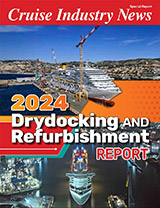Leading international classification society Bureau Veritas has published new rules for Polar Class vessels and specific guidance on ice/structure interaction. The rules are aimed at speeding Arctic and Caspian Sea oil and gas development by facilitating the building of tank, cargo and offshore service vessels which can operate unsupported by icebreakers in very heavy ice. The guidance note aims to facilitate floating LNG and oil platform construction in high Arctic conditions.
According to Philippe Baumans, director of development, Bureau Veritas, “BV’s new “Rules for the Classification of POLAR CLASS and ICEBREAKER Ships”, bring together for the first time the requirements for icebreakers and the requirements for Polar Class cargo and other service vessels such as oilfield support vessels. Our Polar Rules covered the requirements for ships operating in the high Arctic, accompanied by an icebreaker, and there are separate rules for icebreakers. But for extracting oil and gas from the Arctic, and also from the very icy and difficult Caspian Sea, there is an increasing demand for vessels which can carry cargo and also ram and break ice unsupported by an icebreaker.
Under our new Polar Rules that is possible, and the owner can choose an icebreaker class from 1 to 7 for the cargo vessel, tanker or psv they need, which will reflect the heaviness of the ice that can be dealt with unsupported.”
BV is currently classing a series of offshore vessels specifically for the Caspian Sea, which has very heavy ice characteristics. “We are considering a specific Caspian notation, as although the ice requirements in the Caspian are similar to the Arctic in some ways, in others they differ,” explains Baumans. “Understanding ice loads and structure in detail is vital to that, as it is for the new generation of offshore floater that will be needed for high Arctic fields such as Shtokman.”
That is why BV has published Guidance Note NI565 “Ice Characteristics and Ice/Structure Interactions”. The purpose of this Guidance Note is to collect and provide data on ice characteristics as well as giving some guidance on the calculations of the forces generated by the ice on ships and offshore structures. It indicates some information on the different types of ice and on their mechanical properties. It gives some analytical formulae and methodologies to estimate the forces applied on the structures due to ice, with respect to the different modes of failure of the ice.
“We have done extensive work with St Petersburg University and Aker Arctic on ice loads, much for the Shtokman project and aimed at clarifying the needs for floating LNG platforms and LNG shuttle tankers.
These guidance notes are a way in which we can share that knowledge with industry,” explains Baumans. “We have further refined our IceSTAR ice load calculation software, which we hope to make available to industry next year. We also expect to publish new rules and guidance for using podded propulsion in ice next year. That will facilitate the development of double acting tankers and gas carriers. They will break ice stern first and make ocean transits bow first, maximising the hull form efficiency in each environment.”




